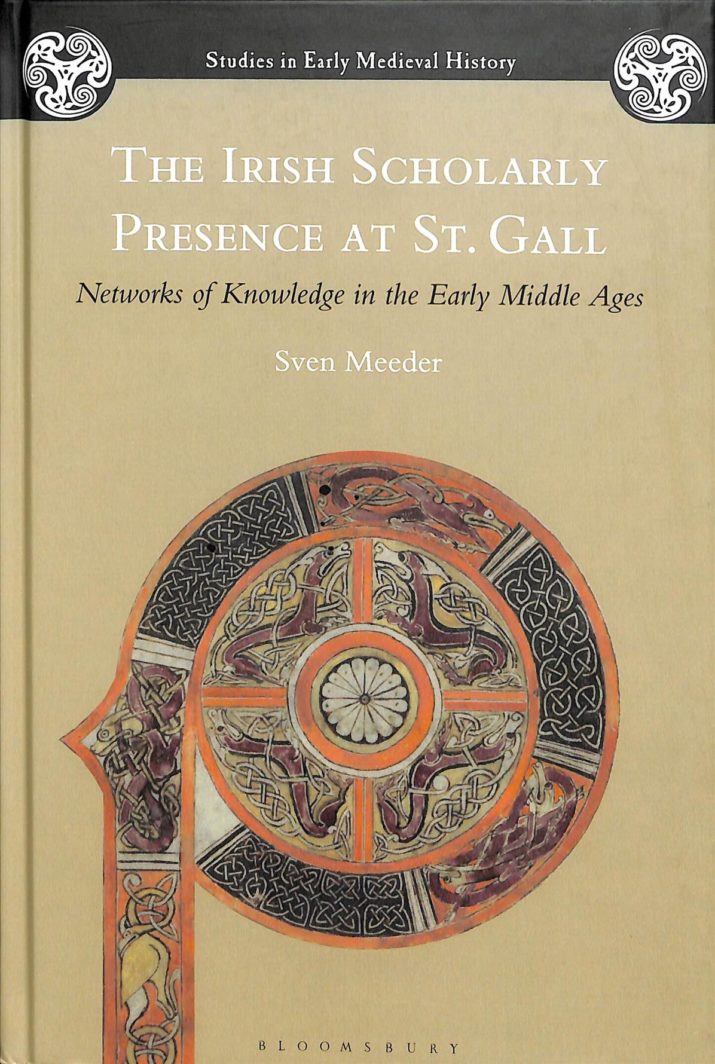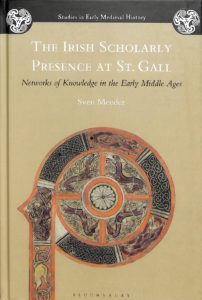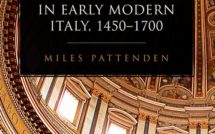
The Irish Scholarly Presence at St. Gall: Networks of Knowledge in the Early Middle Ages by Sven Meeder
 The notion that early medieval Ireland was an island of “saints and scholars,” a bastion of civilization-saving monks and their rich corpus of well-travelled books and manuscripts, is something of a popular truism. Scholars, too, have also readily identified Irish scholarship’s significant contributions to monastic, spiritual, and intellectual life in the eight and ninth centuries. But few, if any, as Sven Meeder notes in his thought-provoking work, have examined fully how early medieval Irish scholarship attained its position of splendor, particularly on the European continent, during the Carolingian revival of learning.
The notion that early medieval Ireland was an island of “saints and scholars,” a bastion of civilization-saving monks and their rich corpus of well-travelled books and manuscripts, is something of a popular truism. Scholars, too, have also readily identified Irish scholarship’s significant contributions to monastic, spiritual, and intellectual life in the eight and ninth centuries. But few, if any, as Sven Meeder notes in his thought-provoking work, have examined fully how early medieval Irish scholarship attained its position of splendor, particularly on the European continent, during the Carolingian revival of learning.
Meeder focuses on the Alpine abbey of St. Gall—situated atop the crypt of the seventh-century Irish saint Gallus, a companion of Columbanus—in order to understand how Irish learning gained its influence, how it was spread, and the role Irish identity played in the dissemination of such scholarship. He posits that there existed a rather expansive continental network of Irish scholarship that relied on significant continental contributions to its diffusion. By placing Irish scholarship within its continental context, Meeder argues that the spread and reception of Irish learning was not uniquely isolated from European scholarship; rather, it was integrated closely into a robust continental intellectual exchange. Meeder is concerned with examining what he terms “the early medieval infrastructure of scholarship” (9)—the ways in which texts and ideas moved and were exchanged. In probing the mechanics of the diffusion of Irish learning, Meeder does not seek to devalue the Irish contribution to the Carolingian intellectual revival; rather, he considers it a key way to more fully acknowledge the profound influence and continental appreciation of Irish scholarly accomplishments in the early Middle Ages.
The book is divided into two parts. The first examines the role of the Irish element at St. Gall in three chapters on the nature of the abbey’s Irish identity; the presence of Irish peregrini, or pilgrims, at St. Gall; and the abbey’s collection of Irish books. Of particular note is Meeder’s examination of the Irish roots of the abbey’s namesake, Gallus, in Chapter 1. The author considers a series of hagiographical texts written about Gallus’ life: an anonymous, and likely Merovingian Vita S. Galli uetustissima, and two Carolingian accounts by the scholars Wetti and Walahfrid Strabo. Through a close analysis of the surviving manuscripts, Meeder emphasizes that there is an intriguing lack of references to either Ireland or Irishmen in these hagiographies: there are little to no mentions of Hibernia or scoti, for instance.[i] In Wetti’s Vita (II) S. Galli, the author neither elaborated on Gallus’ Irish origins nor described Ireland’s geography or religious status, but he did refer to Gallus has having spent “the flower of his youth” in Ireland (22). Walahfrid did more to establish Gallus’ Irish credentials, but he wrote nothing of his Irish birth, and instead focused on the notion that Gallus was committed to the care of Columbanus early in his life in Ireland. Walahfrid also offered a short description of Ireland, but even this is subordinate to a description of Alemannia, the region where St. Gall was situated that was later incorporated into the southwestern portion of the Holy Roman Empire. In Walahfrid’s hagiography, Ireland was described in order to stress its distance from Alemannia, a device employed to highlight that Gallus, and Columbanus, travelled from the farthest limits of the known world to save Alemannia and its people. Both Wetti and Walahfrid’s accounts also allow for the potential of Gallus’ non-Irish birth. Thus the saint’s origins, Meeder explains, are not so clear-cut: if anything, Gallus’ Irish pedigree is mostly assumed because of his association with Columbanus.
One might assume that Gallus’ obscure origins might have led to something of an identity crisis for the abbey, but Meeder argues instead that we lack allusions to and descriptions of medieval Ireland and accounts of Gallus’ Irish birth because St. Gall’s hagiographers were largely uninterested in the saint’s early life—they were certainly convinced that he hailed from Ireland, but his Irish origin was merely auxiliary. Ireland’s distance, more so than any unique Irish religious and intellectual essence, were emphasized in the hagiographies, as was Gallus’ connection to Columbanus. Gallus travelled a great distance to come to Alemannia, and he was evoked and celebrated for his ascetic piety and sanctity, irrespective of his ethnic origin.
This idea permeates Meeder’s analysis: Ireland and Irishness were of a supplementary, even secondary nature to the abbey of St. Gall’s growth as religious and intellectual center. In Chapter 2, Meeder examines the Irishmen who travelled to the abbey, which was located on a pilgrimage route connecting the north of Europe to Rome. Meeder contends that the “majority of the faithful” visiting the abbey, and particularly Gallus’ grave, must have been non-Irish (40). Though Walahfrid suggested that there was a steady stream of Irish travellers to the region, it is likely that they would have been ignorant of the life of the saint; indeed, Gallus’ saintly miracles would have been better known to the local Alemannic religious and lay populaces. Itinerant scholars, however, provide a particularly important way to consider St. Gall’s place in the continental intellectual network. The tenth-century scholar Ekkehard IV recounted the presence of two such Irish scholars who elevated the abbey’s status: the bishop Marcus and his nephew Marcellus, who arrived at the abbey sometime in the mid-ninth century. It is uncertain, however, if the scholars were heralds of Irish learning—indeed, from the surviving evidence, Meeder concludes that none of the books they carried were scholarly works originating from Ireland. Meeder argues that this is significant for two reasons. Firstly, it undercuts the idea of Irish itinerant scholars spreading scholarship composed in Ireland—in this case, two well-connected Irish scholarly visitors to a robust intellectual center like St. Gall played no role in the diffusion of Irish works. Secondly, however, it does illuminate the vital role of Irish scholars in the spread of continental learning. Thus, for Meeder, Irish learned men were actively engaged in early medieval Europe’s intellectual blossoming, and the part they played was not limited to disseminating the works of their countrymen. Meeder expands on the idea that Irish peregrini facilitated the exchange of continental and Anglo-Saxon texts in Chapter 3. In his examination of St. Gall’s surviving library lists, Meeder notes that the monks earmarked a list of 29 texts, the libri scottice scripti—“books written in Irish fashion”—as separate from the abbey’s holdings. The texts were recognized not for their Irishness, but rather for their “overall usefulness” (62), and they included biblical books, canonical tracts, hagiographical texts, and schoolbooks. Moreover, all but the most beautiful were later discarded or used to strengthen the bindings of other manuscripts. The existence of these texts offer strong evidence that at St. Gall, there was a lively transmission of Irish books that arrived with Irish and Anglo-Saxon peregrini, who required useful primers on their treks to Rome. Further, because many were later discarded, the library lists suggest that the books were not in fact a key part in St. Gall’s intellectual network.
Thus, in the first half of his book, Meeder does much to de-mythologize the status of Irish learning in the early medieval period. Rather than occupying some unique, exalted space in the Carolingian period, Irish scholars, peregrini, and texts were integrated into existing continental networks; what is more, Irish scholarship was valued not because of any intrinsic Irishness, but because of its utility, piety, and wisdom. In Part Two, Meeder examines the texts themselves, focusing specifically on manuscript witnesses to the presence of Irish scholarship at St. Gall in the ninth century. Chapter 4 centers upon the seventh-century treatise De Duodecim Abusiuis Saeculi, or De XII Abusiuis, “the Twelve Abuses,” the most influential Irish work in early medieval Europe. The manuscript dealt with the nature of kingship and just rule, a particularly salient trope found throughout early medieval Irish scholarship. By tracing the routes of the manuscript’s witnesses to and from St. Gall—such as in the book bag of the eighth-century abbot, Grimald—Meeder highlights the abbey’s role as a key facilitator of De XII Abusiuis’ spread to scholarly centers in Bavaria and Hesse. But, again, the text’s influence and its travels reveal little about the currency of an Irish pedigree—St. Gall’s own witnesses, for instance, attributed authorship of De XII Abusiuis to St. Cyprian of Carthage. Rather, it spoke to St. Gall’s positioning as a key hub of continental intellectual and textual exchange, which provided the “backdrop” for the spread of Irish learning via non-Irish means (82).
Chapter 5 focuses on an Irish canonical collection known as Collectio canonum Hibernensis, a copy of which was executed in the mid-ninth century by two St. Gall scribes. Unlike De XII Abusiuis, Hibernensis was much more evidently Irish: the terms hibernenses and sinodus hibernensis proliferate in the text, while the manuscript induces the influence of Irish vernacular law and is replete with both a large number of canons derived from Irish synods and stylistic features emblematic of Hiberno-Latin literature. Yet Meeder is quick to point out that there was very little recognition of either the manuscript’s Irishness or any potential Irish provenance. Indeed, it is probable that Hibernensis was transmitted to the abbey not by Irish peregrini, but by an Anglo-Saxon named Eadberct. It is also not unlikely that it was directly connected to the island monastery of Reichenau, which possessed its own different but nevertheless related version of the manuscript, as well as the same text as St. Gall’s Hibernensis. Chapter 6 focuses on Irish exegesis and penitentials at St. Gall and, once again, Meeder underscores the continental connections of these texts, and particularly the Penitential of Finnian, with European centers, thus further dismantling the idea of the existence of an insular Irish network.
Meeder provides a lucid and erudite study of early medieval intellectual networks and the spread of Irish learning on the continent. He is at his best when engaging in close textual and comparative analyses of the manuscript witnesses under scrutiny; his analysis of the St. Gall and Reichenau copies of Hibernensis is especially noteworthy. The goal of this study is to contextualize the transmission of Irish learning through the case study of St. Gall, an abbey with an Irish patron saint but whose Irish credentials, or at least recognition of its Irish identity and pedigree, seemingly began and ended with its name. Meeder has found no evidence to support the idea that there existed a unique and singular connection between the abbey and Irish scholarship, but instead has produced and interpreted a preponderance of material to argue quite the opposite.
This is an engaging and useful work but it is also quite short. At 111 type-written pages, Meeder would have done well to include a more robust discussion of what precisely characterized the Carolingian revival of learning outside of the few pages he includes in the introduction. Indeed, at times, this vital context can be lost in the body of his study. The author occasionally also employs rather clunky metaphors to describe St. Gall’s role in the transmission of learning: following a discussion of the contested idea of an intellectual bridgehead (6), he does not return to it until the conclusion, where he introduces for the first time the notion of “horizontal” dissemination of scholarship (109) and assigns to St. Gall the rather ignominious moniker of “sink strainer” (110). Such ideas could have been developed further. But these are the most minor of squabbles for what is otherwise a first-rate piece of scholarship.
This study will be of interest to anyone interested in gaining a fuller understanding of the nature of Irish and continental learning and its transmission in early medieval Europe. It dismantles some long-held myths about the status of medieval Irish scholarship, while nevertheless underscoring the extent to which Irish learning was valued for its usefulness, skill, and sagacity. As a case study of a single Alpine abbey, this book will also, hopefully, be the first of many that continue to revise our understanding of intellectual exchange in the early Middle Ages.
[i] Scot(t)i is a Latin term initially applied to all Gaels in Ireland and Britain, but only later, in the tenth century, was it used to identify Gaels in northern Britain, in what would later become Scotland. Thus in the early Middle Ages, Gaels of Ireland—named Hibernia in classical Latin, and first used in the writings of the Roman historian Tacitus in the first century C.E.—would have most likely been identified with scoti. See e.g. Nicholas Evans, “Scotti/Scots,” in Medieval Ireland: An Encyclopedia, ed. Seán Duffy (London: Routledge, 2005), 421–22..
Reviewed by Salvatore Cipriano, Boston College
The Irish Scholarly Presence at St. Gall: Networks of Knowledge in the Early Middle Ages
by Sven Meeder
Publisher: Bloomsbury Academic
Hardcover / 200 pages / 2018
ISBN: 9781350038684
To read more book reviews click here
Published on December 11, 2018.




